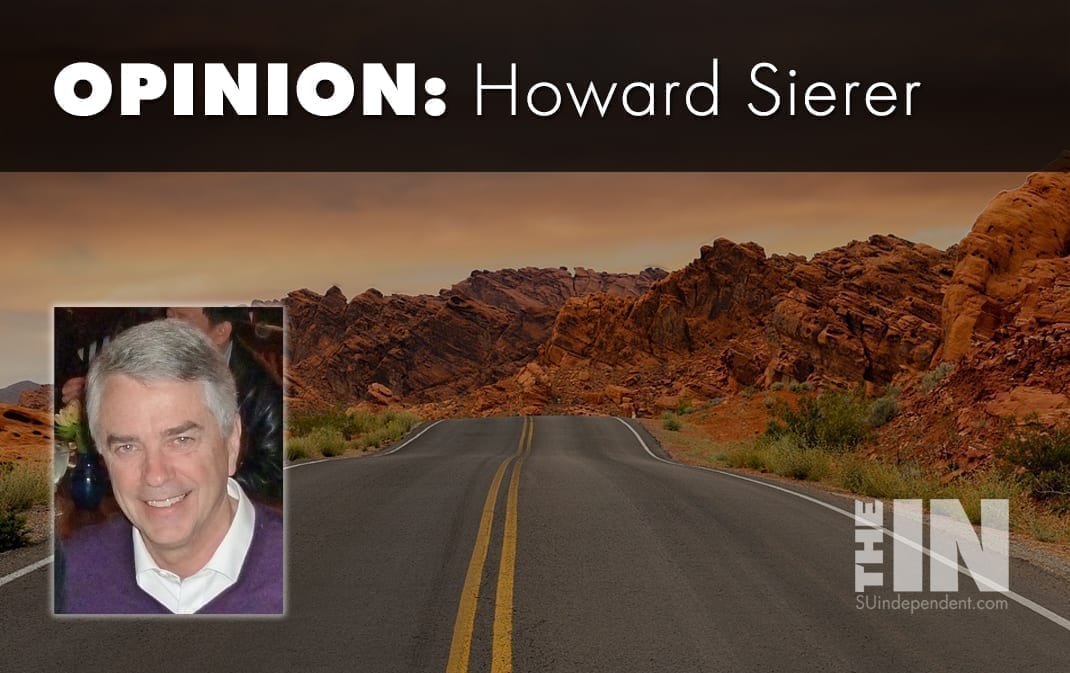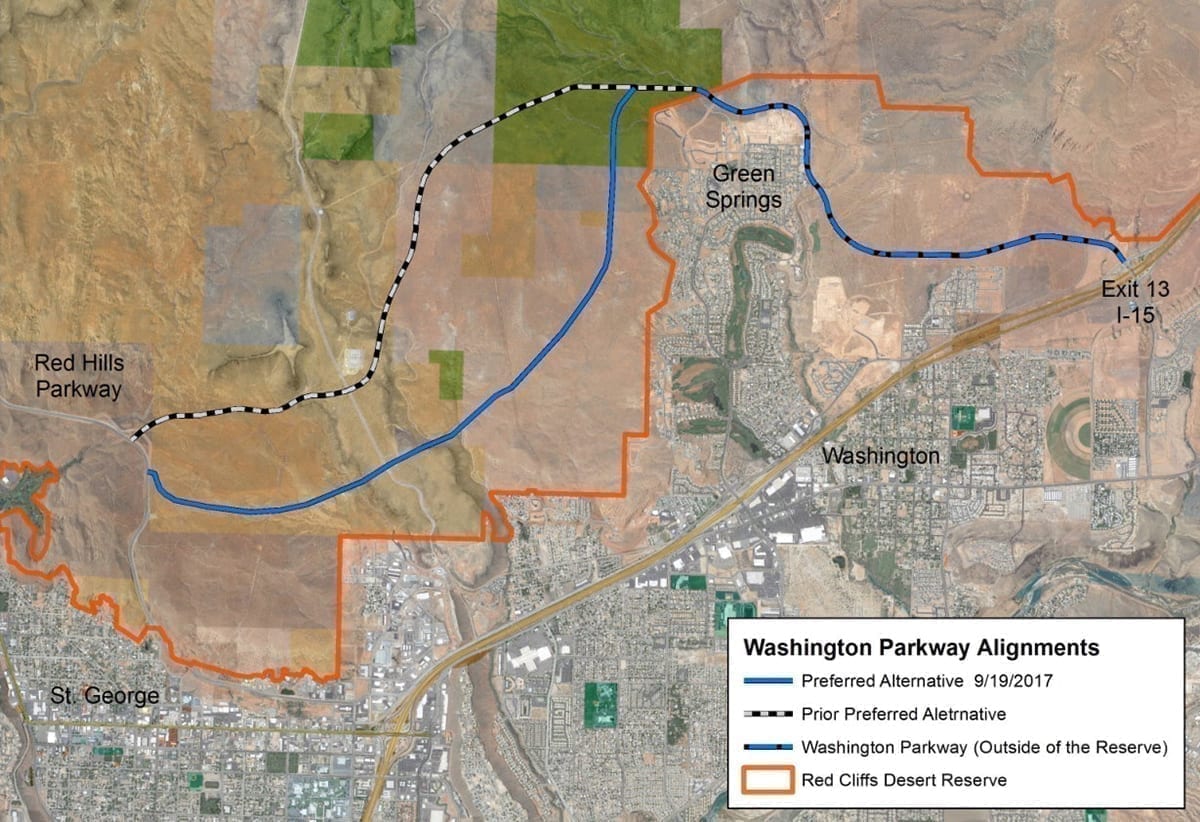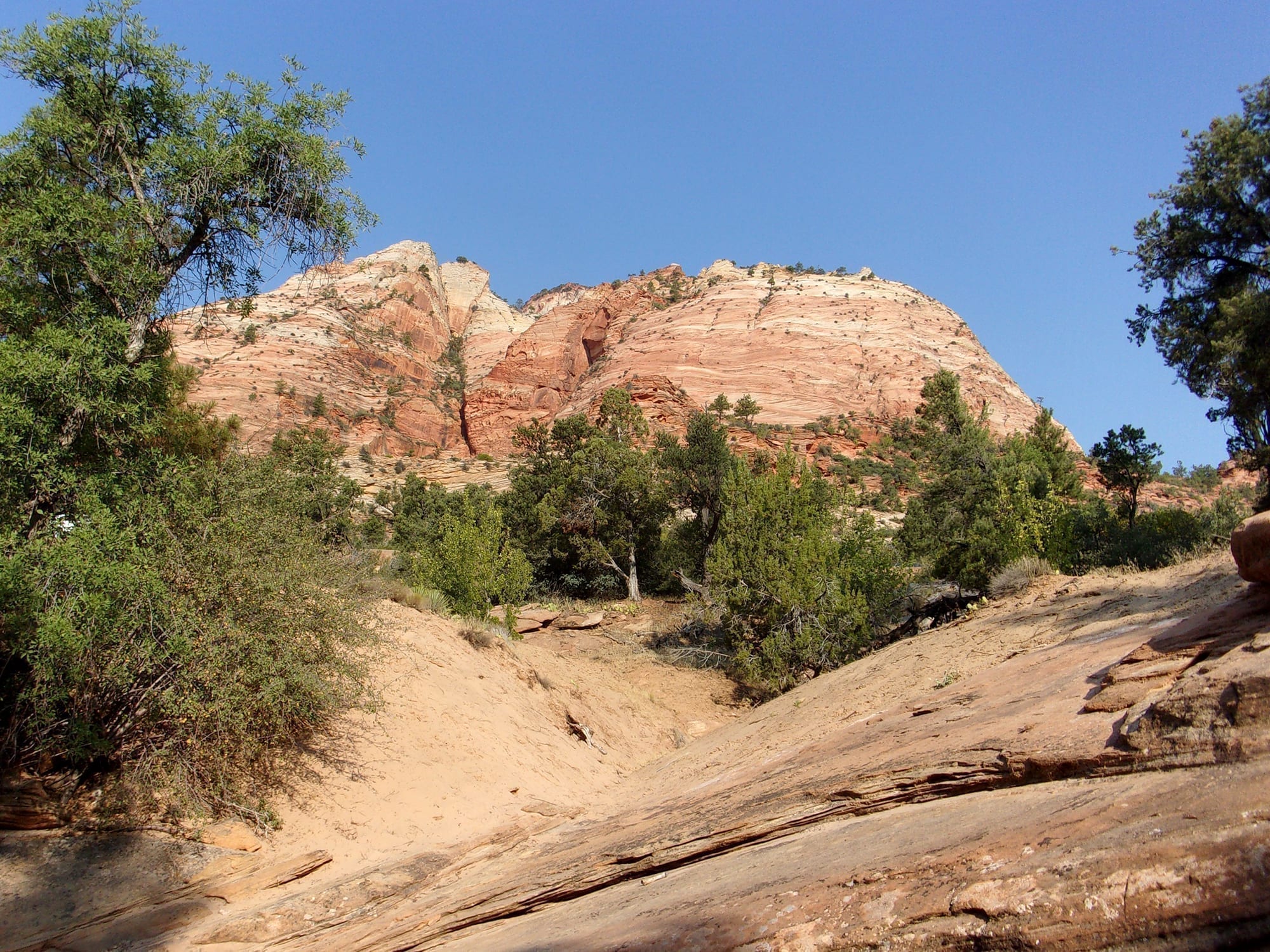
Northern Corridor Highway: Eating Our Cake and Having It Too
By Howard Sierer
When it comes to choosing the Northern Corridor Highway route, we can have the best of both worlds, eating our cake and having it too.
I have long supported the need for a Northern Corridor Highway (NCH), in large part because of the great respect I have for the Utah Department of Transportation (UDOT).
Transportation needs in Washington County have been met nicely for the 20 years I’ve lived here, usually in advance of significant traffic congestion. Those who don’t agree, need to spend more time almost anywhere else in the country.
Since UDOT’s preferred NCH route runs through a portion of the Red Cliffs National Conservation Area (NCA) immediately north of St. George, the Bureau of Land Management (BLM) is required to prepare a Draft Environmental Impact Study (DEIS) that compares alternative solutions.
Like all of us, I’ve been urged to read the DEIS and send comments to the BLM. I’ll be honest: my eyes glazed over trying to read the 26 page Executive Summary and I was about to give up. I assumed that UDOT’s preferred route through the NCA was the only viable option to avert future traffic congestion.
Thankfully, an acquaintance pointed out that one of the BLM’s alternatives completely meets UDOT’s transportation requirements without going through the NCA and has essentially zero environmental impact. It’s all there in black and white in the BLM’s DEIS but well-hidden so as not to offend UDOT or other supporters of the NCA route.
Buried in Volume 3, Appendix J of the Highway Alternatives Development Technical Report, Horrocks Engineers supplies two tables comparing UDOT’s preferred NCA route with eight alternatives.
Table 4 on page 16 shows that modifications to create a Red Hills Parkway Expressway and adding “flyover” connections to I-15 does a better job reducing rush hour congestion at key intersections than does the UDOT preferred solution. Table 5 on page 17 shows that the Red Hills flyover results in better or identical peak hour travel times over a variety of routes.
I was shocked: A comparable or slightly better transportation solution with no NCA impact and without the inevitable lawsuits that will follow approval of a route through the NCA, delaying its implementation and adding to its cost. Regardless of how you feel about the desert tortoise, the alternative route looks like a winner.
What about the cost? The Dixie Metropolitan Planning Organization (MPO) estimates that the first phase alone of UDOT’s preferred NCA route will cost $85 million; the MPO estimates that Phase 2 projects would add over $80 million more.
In addition, Washington County would need to spend $16 million over the next 25 years to administer the Zone 6 addition to the NCA if the NCA route is chosen.

The MPO refuses to provide an estimate for the Red Hills flyover alternative but in 2017 UDOT estimated a flyover would cost $17 million. Even allowing for flyover design modifications, a substantial modification to the Red Hills Parkway interchanges with Skyline Drive and 1000 East and various ancillary required upgrades, the flyover alternative would cost far less.
Ignoring the facts, the Dixie MPO dismisses the Red Hills flyover alternative by saying it “would render some traffic congestion relief, but based on concept studies, the flyover does not provide sufficient traffic relief needed by 2050 or even 2040.” The MPO offers no supporting data and its statement is completely at odds with Horrocks’ data in the DEIS.
The Dixie MPO goes on to complain that the alternative would require “extensive and difficult widening and environmental impacts throughout.” That’s arm-waving of the worst kind: widening an existing roadway can’t be more difficult than building a new roadway that will need extensive soil testing, grading, and a number of small bridges over drainage channels and tortoise under-crossings. The MPO also contradicts the BLM’s statement which says environmental impacts from the Red Hills flyover would be “minimal.”
The MPO goes on to say that the flyover doesn’t provide “back-end” relief for Green Springs drivers to avoid congestion at the Green Springs freeway interchange. These drivers will have the new Washington Parkway linking them to I-15 Exit 13 and few of them would have any reason to go west through the NCA to Ivins or Santa Clara on a regular basis.
I’m an engineer; I deal with numbers and facts. If the Dixie MPO has real data to back up its arm-waving, we’ll all benefit from seeing it.
I’m 100 percent with our local leaders who back the need for a Northern Corridor Highway. But I suspect they don’t want to “inconvenience” their access to the Water Conservancy headquarters or to city facilities along the Parkway by examining a lower-cost alternative, even when available data augurs for the Red Hills flyover and leaves the NCA intact.
Let’s eat our cake – the Red Hills flyover Northern Corridor Highway – and have it too, by preserving the NCA.
Viewpoints and perspectives expressed throughout The Independent are those of the individual contributors. They do not necessarily reflect those held by the staff of The Independent or our advertising sponsors. Your comments, rebuttals, and contributions are welcome in accordance with our Terms of Service. Please be respectful and abide by our Community Rules. If you have privacy concerns you can view our Privacy Policy here. Thank you!
Click here to submit an article, guest opinion piece, or a Letter to the Editor





Your comment that the Red Hills Parkway Expressway flyover alternative would cost far less than the Northern Corridor seems like a gut instinct reaction, or maybe just a parroting of Conserve Southwest Utah’s position, rather than based on a thorough review of the Draft EIS alternatives analysis. The 2018 UDOT Flyover proposal was for one single lane bridge to connect eastbound Red Hills Parkway to northbound I-15. It was reviewed and the modeling showed that there was not enough benefit to the project to prevent the need for the Northern Corridor and therefore was dismissed. Clearly, a more substantial project was needed to replace the Northern Corridor. Now that the Draft EIS has presented the full scope of what a more substantial flyover project would look like, those that want to promote the flyover project should study it closer. If you did, you will notice that that there is are now two flyover bridges connecting to I-15, widening of Red Hills Parkway from 5 lanes to 7 lanes, elevating the Parkway over the top of the intersections at 1000 East and 200 East creating interchanges that required bridges, off ramps and on ramps, and purchasing private businesses, hotels, stores and warehouses. Not to mention that since these interchanges and bridges are constrained in an dense urban environment, it will require massive retaining walls which by themselves could cost millions and millions of dollars and make the City of St George look like a spaghetti bowl instead of a City. I think you should rethink that position statement and review the alternative a bit closer. Even if it is a bit cheaper, and I do not believe that it is, do we want to destroy Pioneer Park and the Red Hills Desert Garden? Those are great assets to our region.
Mr. Gillette,
My column accused the MPO of “arm waving” by making statements on its web site that were completely at odds with the DEIS. Your generalizations above are more of the same and as shown by the comments below, also at odds with the DEIS. My column explained that as an engineer, I deal with facts and numbers. I look forward to seeing the facts and numbers that back up your comment above; I stand ready to modify my position if they support routing the NCH through the NCA.
Mr. Sierer,
I am also an engineer that works in this industry and I was hoping that by pointing out facts that are in the DEIS you might see your own comment as nothing better than arm waving. I sincerely appreciate your openness to changing your stance with better information. Unfortunately, the BLM does not consider the cost to be a factor in their decision making and thus we have no cost estimates. I am sure we will in the near future and I look forward to it so we can all stop the arm waving. I just couldn’t stand by while misinformation on this is being spread around.
I am sooooo disappointed that you let this article run in the St George News without any modification to your “arm-waving comment of the worst kind” that the Red Hills Parkway Flyover “will cost far less” than the Northern Corridor.
I honestly tried to help you understand that it was a terribly incorrect statement by pointing out the major scope difference between the UDOT project and this BLM alternative. You could have at least toned it down, but you chose to ignore the facts and double down.
I am still counting on you to honor your promise to retract the statement later when the data is publicly released… I’m guessing it will be only to the 3 people that are following this comment string, unfortunately. It just irks me to no end to see people get mislead by this $17M flyover comment! I was hoping you as an engineer would get it.
I’m soo disappointed. (I would have just sent this to you privately but I don’t have an email for you.)
Mr. Gillette,
Since neither the MPO nor you have provided any cost estimates for the Red Hills Expressway, I stand by my column’s qualitative statement that “Even allowing for flyover design modifications…the flyover alternative would cost far less.” By the MPO’s own estimates, the NCA route will cost $181 million over the next 25 years. That provides a lot of margin for constructing two, 2-lane flyovers, a new Skyline Drive interchange and modifying the existing parkway.
A careful reading of my column will show that my “arm waving” comment applied to the MPO’s web site statements about environmental impacts that were either contradicted by the DEIS or were not supported by it.
Rather than fulminating about cost numbers that neither of us have, perhaps instead you’d like to comment on today’s County email that claims that the Red Hills Parkway route “WOULD require the removal of Dixie Rock.” That lie looks like a blatant scare tactic; do you agree with that statement? That’s a far more egregious attempt to sway public opinion than two engineers disagreeing about construction cost estimates. Will either you or the county apologize when that turns out to be false?
A little quantitative data for your consideration. The I-15 widening project from Bloomington to Exit 6 that included removing two existing long and tall bridges over the Virgin River and replacing them with two new four lane bridges cost $25 million. Widening Bluff Street from Tabernacle to Sunset cost $51 million. Allowing for some inflation, both projects could be done today for under $100 million.
While the MPO will undoubtedly inflate its cost estimate for the Red Hills Expressway to make it look less appealing, I find it hard to believe that the Expressway could cost more than these two previous projects combined. Hence until realistic estimates are forthcoming, I stand by my statement that “the flyover alternative would cost far less” than the MPO’s $181 million estimate for the NCA route.
If the Expressway cost is comparable to the NCA route, I’ll apologize…right after you get the County to apologize for it’s outrageous statement that Dixie Rock would have to be destroyed to accommodate the Red Hills Expressway alternative.
I think you just retracted your promise to me based on something a politician said? Really? Does that make any sense at all? Again, disappointed.
I am at least happy that you have done enough research to now know that the Red Hills Parkway Expressway flyover project will cost far more than $17M.
Chuck, I’m concerned with the accuracy of your statement that the Red Hills Parkway Expressway would “destroy Pioneer Park and the Red Hills Desert Garden.” The draft Environmental Impact Statement (EIS) that analyzed Northern Corridor Highway alternatives includes multiple sections that contradict this claim:
The draft EIS states on pg 3-6 that:
“The Red Hills Parkway Expressway environmental analysis is based on a conceptual roadway design that assumes no additional ground disturbance outside the current fencing would be necessary.”
Perhaps you’re concerned that if Red Hills Parkway functions as an Expressway it will make access to Pioneer Park more difficult, but this too is addressed in the Draft EIS on pg. 2-4:
“Additional widening of Red Hills Parkway at various locations between 200 East and 900 East would be required to add exclusive turning lanes for access to individual properties or public use areas where feasible.”
More information on possible impacts to Pioneer Park is found on pg. 3-136:
“Construction of the Red Hills Parkway Expressway would require ROW acquisition on approximately 0.9 acre of Pioneer Park…This would constitute a conversion of use. The acquisition would occur directly adjacent to the existing Red Hills Parkway, and would encroach on areas not actively used for recreation. None of the outdoor recreation facilities would be affected; however, ingress and egress points to the park may require reconfiguration to facilitate the expressway and ROW requirements.”
And on 3-135:
“Long-term access to Pioneer Park would be maintained, but final design could result in access modifications such as changes to ingress and egress points. The availability of recreation opportunities at the park would remain unchanged. In addition, with its existing urban interface and location adjacent to a widely used existing road, the overall visitor experience is not expected to substantially change.”
I agree that Pioneer Park and the Desert Garden are great assets to our region, but I don’t see any evidence that they will be harmed by the Expressway Alternative. I would also add that the Red Cliffs Desert Reserve and National Conservation Area is a great asset to our region. The Red Cliffs NCA improves local quality of life because it protects exquisite scenery, open space, world-class recreation, and acts as a refuge for residents in our fast-growing area.
My comment was based on my opinion that squeezing more traffic closer to these parks and potentially having to change the accessibility to right-in and right-out only entrances is a detriment to these parks. I have a hard time understanding any arguments trying to refute that. I guess one could say that it’s not that bad and it doesn’t necessarily “destroy” these parks, I could accept that as a legitamate argument, but it does impact them and it does reduce the value of them.
Thanks for withdrawing your claim that the Red Hills expressway would “destroy” Pioneer Park and the Desert Garden. “Reducing their value” is your opinion which happens to disagree with the BLM’s assessment that “the overall visitor experience is not expected to substantially change.”
You’re certainly entitled to your opinion and you’re apparently willing to spend millions of public sector dollars and years of time by arguing for an NCA route that will be challenged in court. An alternative is available with comparable traffic performance and similar if not less cost and that has “essentially zero” (BLM’s words) environmental impact.
I expect the BLM to fulfill its environmental mandate by acknowledging that the Red Hills Expressway meets all requirements while minimizing environmental impacts.
The DEIS information reveals there will probably be very little impact to Pioneer Park and the Desert Garden. As for other facilities on Red Hills Parkway such as the water district’s huge facility and St. George facility I will only say this. The water district’s lower parking lot along Red Hills Parkway is probably all that would be affected and it’s virtually empty every time I drive by. And, UDOT and the City of St. George are never averse to burdening private businesses with impacts to their property when road work is needed such as Bluff Street/Hwy 18. Now that the shoe is on the other foot, St. George is upset? In “Volume 3: Glossary and Appendices” Table 4 “Transportation Analysis: 2050 Evening Peak Hour Intersection LOS Results” of the DEIS reveals how the Northern Corridor alternatives compare when moving traffic and dealing with congestion by 2050 and Alternative 5, Red Hills Parkway Expressway performs as well or better than UDOT’s Alternative 3. See page 250 of full document (Page 16 of Appendix J: Highway Alternatives Development Technical Report by Jacobs): https://eplanning.blm.gov/public_projects/1502103/200341977/20019245/250025449/DEIS_Vol3_Glossary_Appendices_NorthernCorridor_WashingtonCtyITP.pdf.
Lisa, I think St. George’s experience with widening Bluff Street explains why they care so much about not going through it all over again. Some pain is worth avoiding even if it is the lowest cost option. I think your statement should be revised to St. George and UDOT are not averse to impacting private property when they have exhausted all other possibly acceptable options. And now we can understand why we have a Bluff Street with these strange little curves in them all in a laudable effort to minimize the impact.
Chuck, when it comes to running a road through Red Cliffs or minimally affecting a few venues along Red Hills Parkway (nothing like all the businesses affected along Bluff Street and the “laudable” efforts to minimize impacts), I think UDOT and St. George have exhausted “reasonable” alternatives. Expansion of Red Hills Parkway was approved in the original Habitat Conservation Plan and now they have the opportunity to stick to that agreement with the expressway/flyover alternative and honor the agreements by those who came before them.
Build a tunnel. It leaves the parkway unaffected, zero impact on the NCA, would be a straight-line much shorter route, and the Tortoises wouldn’t even know it’s there 20 feet under the desert.